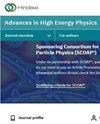Probing Triple Higgs Self-Coupling and Effect of Beam Polarization in Lepton Colliders
IF 1.1
4区 物理与天体物理
Q3 PHYSICS, PARTICLES & FIELDS
引用次数: 0
Abstract
探测三重希格斯自耦合及轻子对撞机光束偏振效应
几乎所有未来(轻子)对撞机的主要目标之一是测量标准模型中三重希格斯粒子的自耦合。通过延长标准模型的标量扇区,使用初始希格斯双重态和二次(希格斯)势可以揭示模型的许多初始特征以及出现额外希格斯自耦合的可能性。希格斯玻色子的自耦合有助于重建标量势。本文的主要目的是通过数值分析由两个希格斯双重态模型(2HDM)控制的几个散射过程来提取希格斯自耦合。这些散射过程包括三重希格斯扇区中最终态的各种可能组合。在入射光束有极化和无极化两种不同情况下,对散射过程的产生截面进行了确定,并将其扩展到质能中心高达s = 3 TeV。计算是在1型2HDM中进行的。这里,我们考虑精确对准极限(s β α =1)和额外希格斯态质量相等的情况,即:m H = m H0 = m A0 = m H± .这种选择使倾斜参数最小化。研究了每个过程最终状态的衰减,以估计在1 a b−1和3的综合光度下的事件数A b−1。
本文章由计算机程序翻译,如有差异,请以英文原文为准。
求助全文
约1分钟内获得全文
求助全文
来源期刊

Advances in High Energy Physics
PHYSICS, PARTICLES & FIELDS-
CiteScore
3.40
自引率
5.90%
发文量
55
审稿时长
6-12 weeks
期刊介绍:
Advances in High Energy Physics publishes the results of theoretical and experimental research on the nature of, and interaction between, energy and matter. Considering both original research and focussed review articles, the journal welcomes submissions from small research groups and large consortia alike.
 求助内容:
求助内容: 应助结果提醒方式:
应助结果提醒方式:


